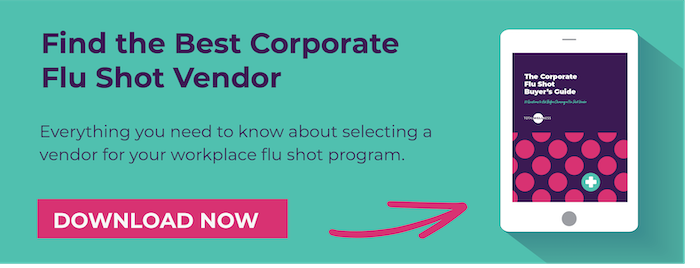Your office space is the definition of close quarters. Everyone is in the same space, sharing equipment, and spending their entire workdays together. That means when one employee gets sick, it won’t be long until everyone else has caught the bug too. In a matter of days, you could have an office epidemic on your hands.

If you start to notice an outbreak of the flu – or any illness, for that matter – there are some things you can do to make sure you’re still able to do business efficiently out of your office.
How to Handle a Surge of Flu Cases in the Workplace
1. Communicate
Your employees – both ill and healthy – need to know what’s going on. When the chaos of mass illness hits your office, you need to keep everyone in the loop. The easiest way to do that is through open communication. Always be sure to communicate the following:
- Inform your employees that a few people are out of the office sick.
- Remind employees what your sick-day policies are.
- Educate employees on how to stay healthy and stop the spread of germs.
- Send out informative emails on topics such as “how to properly wash your hands” or “how to avoid spreading germs around the office.”
- Let employees know who is covering which tasks while people are gone.
Discussing these important topics will help get all of your employees on the same page. Keeping them informed on best practices during flu season also helps reduce the number of germs spreading around the office.
2. Delegate
If a lot of your employees are out on sick leave, you might need to step in and delegate vital tasks to working employees. For example, if Bob is responsible for covering Tim, but Tim is responsible for covering Janet, how much work does Bob have to do if both Tim and Janet are out sick?
Those are the types of questions employers should think about and create a plan for. Consider who is still available to show up to work, and who has offered to work from home. Prioritize the tasks you have queued up, and assign responsibilities accordingly.
3. Isolate
The best way to stop a flu outbreak is to isolate the employees who are sick – and no, we don’t mean locking them in some quarantine room! But you do need to encourage them to stay home if they’re not feeling well. If they must work, let them work from home – but don’t allow them to bring their illness into the office.
When people at work start to get sick, it’s important to be intentional about keeping healthy employees healthy. Keep the office clean and disinfected, sanitize shared equipment, and educate employees about the spread of illnesses and germs.
4. Advocate
When things get chaotic due to an office flu epidemic, teamwork is key to sailing through it. Flexibility helps as well. You’ll need to demand both teamwork and flexibility from your employees.
If you expect teamwork and flexibility, then you need to be a valuable resource. Support your employees, and provide the necessary tools that healthy employees need to get tasks done outside their normal job description. Ultimately, it’s important employers realize that they’re asking a lot from their employees to continue to work like it’s a normal workday while in a crazy, stressful environment. Which is why it’s essential to help your employees in any way possible, and let them know that you’re their biggest advocate in tough times.
Sometimes you can’t avoid an outbreak at work, and the best thing to do is face it head-on. Other times – like during flu season – you can put yourself in an awesome position to skip the troubles altogether. One way to do that is to be sure a majority of employees have gotten their flu shot.
You can make flu shots an easy decision by bringing them into your workplace – and we can help! If you’d like to learn more about setting up a corporate flu shot clinic and avoiding an office outbreak, let us know in the comments below!
Like this blog post? Share it with your employees or co-workers with this printable version of the blog!
Editor's note: This blog and guide were originally published in September 2016 and has been updated for freshness, accuracy, and relevance.
Image created by Freepik



